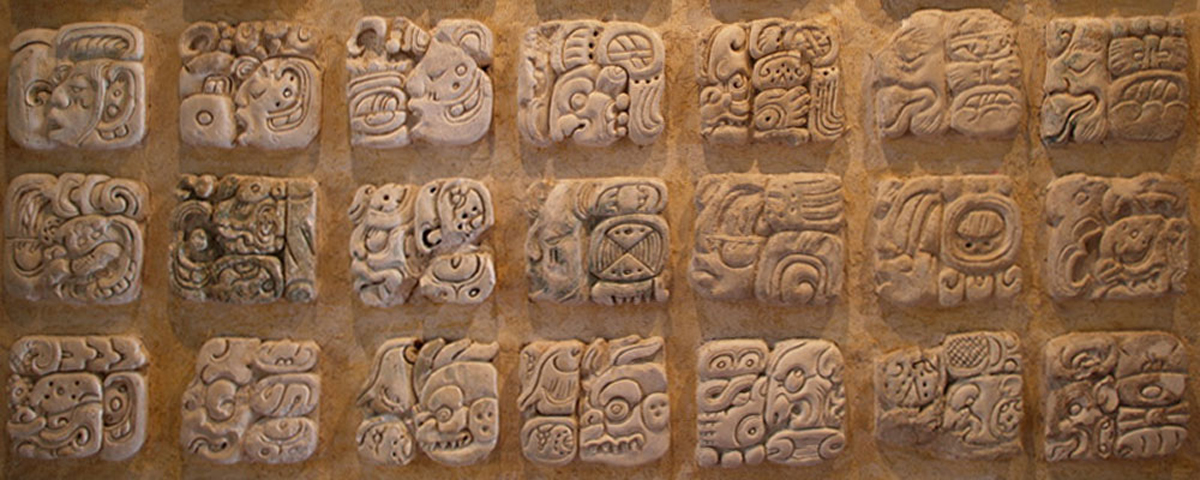Mayan Scripture
The Mayan civilisation lasted from 500 BC to 1200 AD, with a classical period from 300-900 AD. The earliest known writing in the Mayan script dates from about 250 BC, but the script is thought to have developed at an earlier date.
The Maya developed a highly complex system of writing, using pictographs and phonetic or syllabic elements. Their writing was highly sophisticated, probably only members of the higher classes were able to read their symbols.
The Maya wrote using 800 individual signs or glyphs, paired in columns that read together from left to right and top to bottom. Maya glyphs represented words or syllables that could be combined to form any word or concept in the Mayan language, including numbers, time periods, royal names, titles, dynastic events, and the names of gods, scribes, sculptors, objects, buildings, places, and food. Hieroglyphic inscriptions were either carved in stone and wood on Maya monuments and architecture, or painted on paper, plaster walls and pottery.





The Maya carved these symbols into stone, but the most common place for writing was probably the highly perishable books they made from bark paper, coated with lime to make a fresh white surface. These "books" were screen-folded and bound with wood and deer hide. They are called codices, codex is singular. Because of their perishable nature and zealous Spanish book burning, only four codices remain today.
The contents of the codices must have varied, but some of them were evidently similar to astronomic almanacs. We have examples of a Venus table, eclipse tables in a codex in Dresden. There is a codex in Paris that seems to contain some kind of Maya Zodiac, but if it is and how it must have worked are still unknown. Another major example of Maya almanacs are present in the Madrid Codex. The fourth codex is called the Grolier and was authenticated as late as 1983. These codices probably contained much of the information used by priests or the noble class to determine dates of importance or seasonal interest. We can only speculate as to whether or not the Maya developed poetry or drama that was committed to paper. The codices probably kept track of dynastic information as well.
The unit of the Maya writing system is the glyphic cartouche, which is equivalent to the words and sentences of a modern language. Maya cartouches included at least three or four glyphs and as many as fifty. Each cartouche contained various glyphs, as well as prefixes and suffixes. There is no Maya alphabet.
Maya writing is difficult to interpret for a number of reasons. First, glyphs do not represent just sounds or ideas, they can represent both, making it difficult to know how each glyph or cartouche should be read. In addition, many Maya glyphs can have more than one meaning, and many Maya concepts can be written in more than one way. Numbers, for example, can be written with Maya numerical symbols or with the picture of a god associated with that number, or a combination of the two. Some glyphs represent more than one phonetic sound, while also representing an idea. This means that a single idea can be written in many different ways. For example, the name of the Palenque ruler, Pacal, whose name literally means "Hand-shield", appears sometimes as a picture of a hand-shield, sometimes phonetically as pa-cal-la, and at other times as a combination of picture symbols and phonetics.
The Maya considered writing to be a sacred gift from the gods. Most ancient Maya could not read, because the knowledge of reading and writing was jealously guarded by a small elite class, who believed that they alone could interact directly with the gods and mediate between the gods and the common people.
In about 1566, the first bishop of Yucatan, Diego de Landa, compiled a key to the Mayan syllabary consisting of 27 Spanish letters and the Mayan glyphs with similar sounds. This became known as the Landa Alphabet and helped with the decipherment of the script, even though it was based on the false premise that the script was alphabetic.
Deciphering Maya texts has become easier with the aid of computers, drawings and the knowledge accumulated over a century of scientific investigation. The hieroglyphic writing of the Maya has not been completely deciphered, however, and can still only be interpreted, rather than read. To date nearly 85 percent of known Maya hieroglyphics have been decoded.
For a long time, many scholars believed that the script did not represent a language at all, or that it wasn't a complete writing system. The first major breakthrough in decipherment came during the 1950s when a Russian ethnologist, Yuri Valentinovich Knorosov, proposed the the Mayan script was at least partly phonetic and represented the Yucatec Mayan language. His ideas were not welcomed by other Mayanists, but he was eventually proved correct.
Further progress in the decipherment was made during the 1970s and 1980s when more linguistics began to take an interest in the script. Today most Mayan texts can be read, though there are still some unknown glyphs.
A gripping account of the decipherment of the Mayan script can be found in Breaking the Maya Code, by Michael D. Coe. The Yucatec Maya continued to use the Mayan script until at least the 16th century. Recently, their descendants have started to learn the script once again from the scholars who have deciphered it.
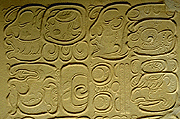
Detail from the Tablet of the 96 Glyphs, in the tower of the "Palace" at Palenque. This is considered one of the most beautiful inscriptions ever carved by the Maya.
From the very beginning, the Maya used writing as a propaganda tool, rather than as a means of recording accurate details of history. In a hierarchical society where the elite competed for prestige and leadership positions, writing was used to reinforce a ruler's military power and to legitimize his descent from noble ancestors and the gods. Writings on stone monuments were designed to place rulers in the most favourable light possible, and ancient sculptural inscriptions deal primarily with historical events, marriages, births, military campaigns and victories, rulers and other dynastic affairs.
Maya glyphs were also painted on codices made of either deer hide or bleached fig-tree paper that was then covered with a thin layer of plaster and folded accordion-style. The inscriptions in the codices were painted by highly trained scribes, and record rituals, chronologies and important events.
Most of the Maya codices were burned by the Spanish during the sixteenth century when they tried to convert the Maya to Christianity. The few codices which have survived, however, are a valuable source of information about the religious beliefs of the Maya and their ritual cycle, and record information about the gods associated with each day in the Maya calendar as well as astronomical tables outlining the cycles of Venus and other celestial bodies.
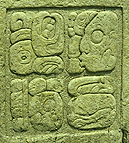
Following the arrival of the Spanish in the sixteenth century, many Maya dictionaries, glossaries and prayer books appeared. These are an important resource in the interpretation of Maya ieroglyphics. The Maya also learned in the sixteenth century to record their own languages using Roman letters, and later Maya works do not feature hieroglyphic writing, but a phonetic rendering of Maya languages in Roman script.
The four known prehispanic codices discovered to date deal exclusively with religious and astronomical matters. They are mostly written in archaic Yucatec, one of the 31 Maya languages
.- The Dresden Codex is 78 pages long, and was probably written at Chichén Itzá between A.D. 1200 and 1250. Some archaeologists believe it may be a half-century older and that it could have been written elsewhere in Yucatán. The Dresden Codex contains almanacs, accountings of days, predictions, tables of eclipses and movements of the planet Venus, as well as prophecies. It is three and a half metres long and is believed to have been painted by at least eight scribes.
- The Madrid Codex is composed of two fragments - it is also called the Tro-Cortesano Codex. It has 112 pages, and contains religious writings and predictions.
- The Paris or Peresano Codex is 22 pages long, and contains predictions and a calendar.
- The Grolier Codex is the most recently discovered of the codices and was first exhibited publicly at the Grolier Club in New York in the early 1970s. It appears to have been found in a wooden box in a cave in Chiapas. It is in poor condition, and contains about half of a 20-page table concerned with the movements of the planet Venus. It has been dated to A.D. 1230, making it the oldest of known pre-Conquest codices.
Other important Maya books include the following:
- The Popol Vuh is the great epic of the Quiché Maya and preserves their sacred and secular history. It was recorded by Quiché Maya rulers in Chichicastenango between A.D. 1554 and 1560, using Roman characters.
- The Chilam Balam are books of songs, prophecies and calendars, preserved by oral tradition and transcribed over and over again. These books contain the observations, calendars and prophecies of the seer or magician named Balam, and are known by their place of origin.
- The Annals of Cakchiquel are also known as the Solola Memorial, and were written in 1605, in the Cakchiquel language. The Annals were first translated into English and later into Spanish, and are similar in content to the Popol Vuh.
- An Account of Things in the Yucatan was written by Father Diego de Landa, who was responsible for the destruction of countless ancient Maya texts, codices and documents. Some consider his book to be an explanation of why he had so many records destroyed; others see it as a penance undertaken by Landa to atone for destroying so much recorded history.
There are also 93 miscellaneous historic and geographic accounts written by the Maya. They discuss aspects of the flora, fauna, inhabitants and ruins, and include customs, traditions and history.
In 1962, the Maya hieroglyphs were first catalogued. Since 1980, a great deal of progress has been made in deciphering new glyphs found at Palenque, Tikal and other sites. Because the writing was often intended as propaganda, care must be taken in its interpretation. However, the ongoing work of decoding the glyphs holds promise that many of the mysteries surrounding the Maya may one day be solved.
Notable features
- The Mayan script is logosyllabic combining about 550 logograms (which represent whole words) and 150 syllabograms (which represent syllables). There were also about 100 glyphs representing place names and the names of gods. About 300 glyphs were commonly used.
- Examples of the script have been found carved in stone and written on bark, wood, jade, ceramics, and a few manuscripts in Mexico, Guatemala and northern Belize.
- Many syllables have more than one glyph
- The script was usually written in paired vertical columns reading from left to right and top to bottom in a zigzag pattern.
Used to write:
Cholan, a member of the Cholan-Tzeltalan family of languages which is spoken by about 90,000 people in Chiapas province, Mexico.
Yucatec or Maya, a member of the Cholan-Tzeltalan family of languages with about 500,000 speakers in the Yucatán peninsula of Mexico.
The Mayan syllabary
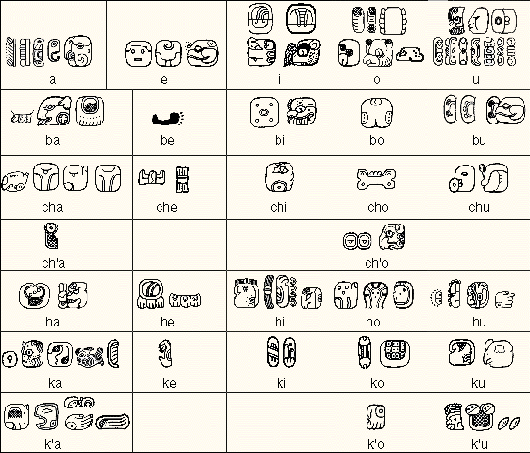
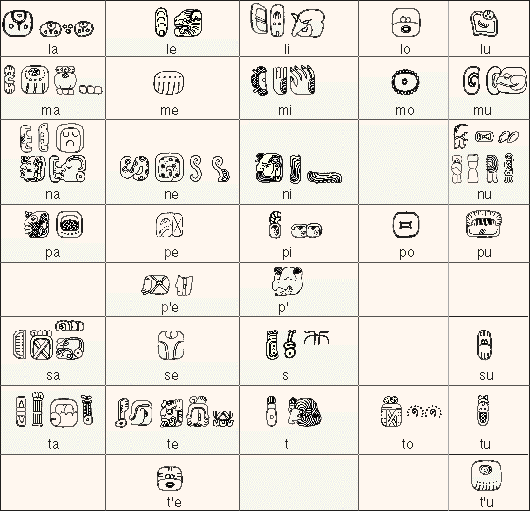
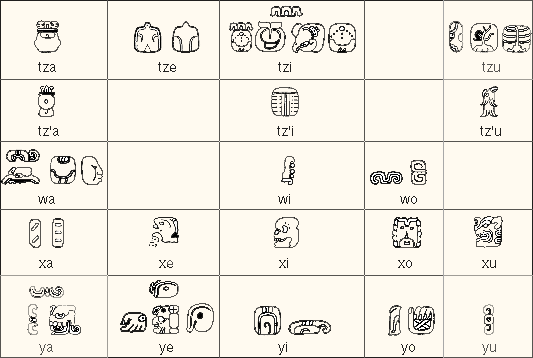
Numerals

 The Maya Civilisation
The Maya Civilisation